Despite their bad reputation for being a bit on the dry side, and prone to disease, turkeys are phenomenal birds. They are sophisticated and regal creatures with awesome personalities. As well as an abundant meat supply, turkeys make fantastic pets. If you do choose to raise them, there won’t be a dull day on your homestead. Raising turkeys is very similar to raising chickens, so if you’ve got chickens you’ll have a bit of a head start. Here is everything you need to know about raising turkeys.
The Benefits of Raising Turkeys
If you’re not sure about raising turkeys, here are some of the benefits to consider:
They Are Clean: If you raise chickens, you know how messy they can be! Well, you won’t have this problem with turkeys because they are relatively clean. They don’t spend their time scratching, so the bedding, water, and feed are not strewn all over the coop.
Meat Production: There is a high demand for turkey meat in local and international markets.
Egg Production: Turkey eggs are larger, firmer, and a lot more flavorful than chicken eggs.
Feather Usage: You can use turkey feathers to do a lot around your homestead including:
- Insulation

- Upholstery padding
- Pillow stuffing
- Fishing lures
- Arrow fletching
- Comforter stuffing
Breeding For Profit: Turkeys are one of the most profitable animals to raise because of the price spikes during the holiday seasons. The majority of homes in America buy at least one turkey during Thanksgiving and Christmas.
Different Turkey Breeds
Although there are not as many turkey breeds as chicken or duck breeds, there is still a wide range to choose from.
Beltsville Small White Turkeys: These are not the most sociable breed but they are prolific layers and the hens are good hatchers. Although they do make good table birds, they are notoriously bland in taste.

Blue Slate: You will also hear this breed referred to as Lavender turkey. They are very popular for meat production because of their strong flavor. The blue slate is exceptionally beautiful in appearance, they are tenacious and strong with a submissive temperament.
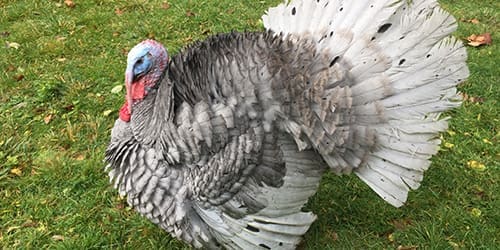
Black Turkey: The black turkey has always been bred for meat production. They are calm and docile, but on rare occasions, they can get aggressive. The meat quality is very flavorful.
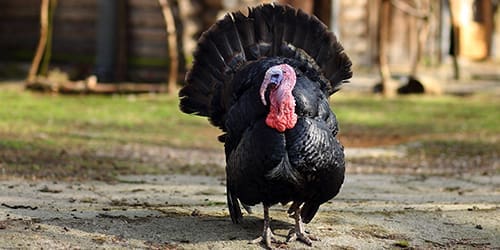
Bourbon Reds: This handsome turkey breed are active foragers. Some birds are docile, others can be very aggressive. Bourbon reds are typically raised for meat production.
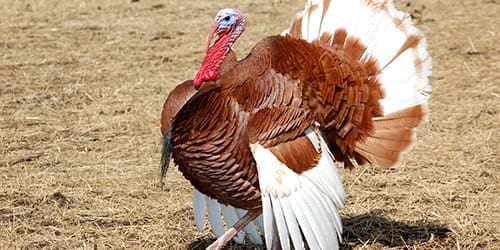
Narragansett Turkey: This historic variety of turkey is known for its excellent meat quality, egg production, and early maturation. They have a calm temperament, and the hens are very maternal.
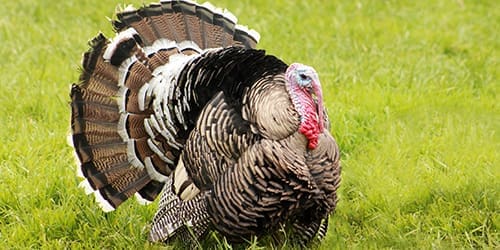
Royal Palm: This striking turkey breed was bred for its attractiveness. They are an active turkey breed, and they do a lot of foraging. The royal palm is suitable for meat production.

How to Feed Turkeys
Turkeys must be fed and watered in a specific way. Before purchasing turkeys to raise, it is essential that you are aware of their needs.
Feeding Poults: Before your poults arrive, you should have feeders and waterers set up because they will want to eat and dip their beaks in the water. A one-gallon waterer is sufficient; avoid open pans, buckets, or dishes of water because poults can fall in and drown.
Egg cartons make good feeders for poults, just tear off the top and use the bottom half. Red plastic chick feeders are also another option. Within a week, you can start using a wooden, or metal feeder. Hanging feeders are more efficient, as long as the turkey poults can reach them. You should also avoid open pails of feed to prevent spilling and poults climbing on top of one another.
Feeding Turkeys: You can switch to a nipple watering system, or a five-gallon metal waterer once the poults turn into turkeys. The waterer should be rugged and sturdy because large turkeys are known for their strength.
Your hanging feeder should be able to hold a 50-pound bag of feed. Once the turkeys are on pasture, they will need access to fine gravel, or coarse sand because it helps with the digestion process.
Foods to Feed Your Turkeys
Feed poults with game bird starter, or chick starter. The starter should be made up of at least 28 percent protein. Feed them this for the first eight weeks, you can then transition to a grower feed with a minimum of 20 percent protein. 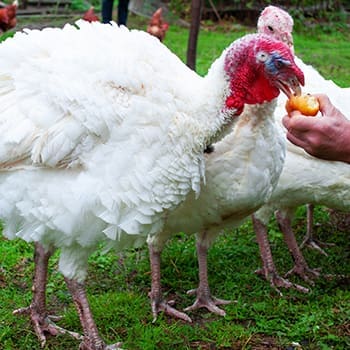
Turkeys typically grow to slaughter size within six months. During this time, the average hen will need approximately 60 grams of food, and the tom will require around 100 grams of the food. In general, you should feed turkeys the following:
- Dried peas
- Millet
- Flax seeds
- Black oil sunflower seeds
- Corn
Foods Not to Feed Your Turkeys
There are some foods you should categorically not feed your turkeys, these include:
- Eggplants: Eggplants contain a chemical called solanine which can be toxic to turkeys.
- Caffeine: Caffeine interferes with calcium absorption and the immune system which can cause lung problems, heart issues, and eventually death.
- Citrus Fruits: There have been some reports that feeding citrus fruits to turkeys cause feather plucking, excessive preening, and prevents calcium absorption.
- Chocolate: Chocolate contains caffeine and theobromine which cause lung, liver, and kidney congestion, vomiting, diarrhoea, and excitability.
- Avocados: The pits, skin, and leaves contain high amounts of a toxin called persin which can poison turkeys.
- Pesticides or Herbicides: Make sure you feed your turkeys organic foods that have not been sprayed with these chemicals.
How to Protect Turkeys From Predators
Common turkey predators include raccoons, foxes, owls, bobcats, coyotes, and the yellow rat snake. You should take the following precautions to ensure your turkeys are protected from predators: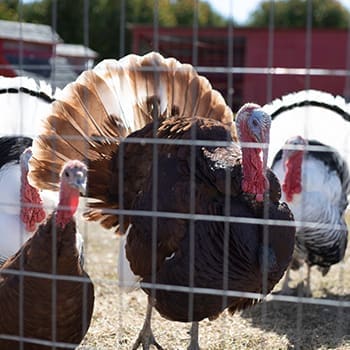
Secure Housing: Make sure latches on doors are properly fastened; sidings should have ventilation and airflow but keep gaps small enough so predators can not reach or climb through. Install chicken wire in offset layers to close any gaps; for mobile range houses, stake the pen down to prevent predators from lifting or burrowing under.
Domestic Animals: Dog breeds such as Anatolian Shepherds and Great Pyrenees will protect turkeys from predators such as coyotes. Donkeys and goats also make good guardian animals for the turkey flock.
Devices: Devices that make it look like light is reflecting off a predator’s eyes will scare them away. However, it is important to mention that such devices don’t always work, therefore, don’t rely on them solely.
Reflective Materials: Reflective materials such as CDs, streamers, and pie pans can be hung around the coop to deter predators who do not like light.
Extra Tips For Raising Turkeys
- During the first week to 10 days, poults can’t regulate their body temperature so they need to be kept warmer during this time. Set the temperature in the brooder at 100 degrees F, and keep dropping it by five degrees each week for 6 weeks. The birds will let you know whether they’re too hot or too cold.
- Adult turkeys enjoy being in groups of between three to six birds in a spacious area.
- If you are raising a free-range turkey flock, every 12 birds will need around a one-half acre of land.
Final Thought
Raising turkeys is an exciting and rewarding adventure. If you’re ready to get started on this journey, be sure to implement the above advice so that you are fully prepared for the experience.
You may also like:
The Berry That Is Illegal To Grow (In Some States) But Perfectly Fine To Forage (Video)
10 Ways to Sow Revolution in Your Backyard (and Why You MUST Go to Battle)
How To Make Your Own Vertical Onion Planter










This is perfect timing! We are considering adding meat birds and turkey is top on our list. Great information that answers a lot of questions one would ask as a beginner. Thank you!
Olga,
Hatched From Happiness Homestead
Vermont